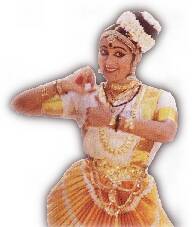
Literally meaning the dance of the celestial enchantress, this sensual dance form of Kerela, contains elements of Bharathanatyam as well as the classical and folk dances of Kerela. Mohiniyattam is usually performed as a solo dance and is very lyrical in its rendering.
Slow, graceful, swaying movements of the body and limbs and highly emotive eye and hand gestures are unique to this dance form. The simple, elegant gold-filigreed dress, in pure white or ivory, is akin to the traditional attire of the women of Kerala. The origin of Mohiniyattom is rooted in Hindu mythology. Once the ocean of milk was churned by the gods and demons to extract the elixir of life and immortality. The demons made away with this divine brew.
Lord Vishnu came to the rescue of the panicky gods and assumed the female form of an amorous celestial dame Mohini. Captivating the demons with her charms, Mohini stole the elixir from them and restored it to the gods. This dance was adopted by the Devadasi or temple dancers, hence also the name ‘Dasiattam’ which was very popular during the Chera reign from 9th to 12th century.
Mohiniyattam is a dance form said to have originated in Kerala. It is closely related to Bharathanatyam of Tamil Nadu,
 which was originally called ‘Dasiyattam’. Originated as the temple dance performed by Devadasis, it portrays feminine love in its myriad forms – carnal, devotional and maternal- with accent more on Lasya and Bhava. In the main items Cholkettu, Padavarnam and Padam, Mudras and facial expressions are more important than the rhythmic steps. Costumes and ornaments of Mohiniyattam have much in common with female characters of Koodiyattam and Kathakali.Once Mohiniyattam was performed only in Temples premises and royal courts. The first reference to Mohiniyattam is found in ‘Vyavaharamala’ composed by Mazhamangalam Narayanan Namboodiri, of 16th century AD. Major contributions to this art form were given by Maharaja Swathi Thirunal, Irayimman Thampi and Kuttikunju Thankachi.
which was originally called ‘Dasiyattam’. Originated as the temple dance performed by Devadasis, it portrays feminine love in its myriad forms – carnal, devotional and maternal- with accent more on Lasya and Bhava. In the main items Cholkettu, Padavarnam and Padam, Mudras and facial expressions are more important than the rhythmic steps. Costumes and ornaments of Mohiniyattam have much in common with female characters of Koodiyattam and Kathakali.Once Mohiniyattam was performed only in Temples premises and royal courts. The first reference to Mohiniyattam is found in ‘Vyavaharamala’ composed by Mazhamangalam Narayanan Namboodiri, of 16th century AD. Major contributions to this art form were given by Maharaja Swathi Thirunal, Irayimman Thampi and Kuttikunju Thankachi. After Swathi Thirunal’s period there was a downfall of Mohiniyattam. It somehow degenerated into eroticism to satisfy the Epicurean life of a few provincial satraps and landlords. The renowned Malayalam poet Vallathol revived it and gave it a status in modern times through Kerala Kalamandalam which is presently doing its best for the development and popularity of Mohiniyattam.
Kalamandalam Kalyanikutty Amma (wife of famous Kathakali artist, late Padmashree Kalamandalam Krishnan Nair) and Chinnammu Amma are well known Mohiniyattam performers. Among the present day artists Kalamandalam Sathyabhama, Kalamandalam Kshemavathi, Bharathi Sivaji, Kanak Rele, Sunanda Nair etc.. are well known artists. Smt. Kanak Rele deserves a special mention as she is not a Malayalee. She has established a Nritya Mahavidyalaya in Mumbai to promote Mohiniyattam along with other dance forms.
Most of the component items of Mohiniyattam are similar to Bharatnatyam and Kuchipudi, though subtle differences of style is obvious. The language used in the lyrics is a pleasant mixture of Malayalam and Sanskrit, known as Manipravalam. Formerly, the Padams were specially composed to include only Sringararasa. Now a days artists are using any classical or semi-classical compositions, even from other language. The real beauty of Mohiniyattam comes through only when mature ladies enact the romantic padams specially written to present the Ashta Nayikas: Swadheena Bharthruka, Khanditha, Abhisarika, Vipralabdha, Kalahandtharitha, Vasakasajja, Proshithabharthruka, Viraholkhanditha.
The accompaniments for Mohiniyattam are Vocal, Veena, Venu, Maddalam and Idakka. Other instruments are also not unusual.
Compared most other dance forms, Mohiniyattam gives more importance to gestural and facial acting. The Mudras (hand gestures) are almost always same as those employed in Kathakali. The artists try to enact the lyrics almost in its entirety, like in Kathakali.

No comments:
Post a Comment